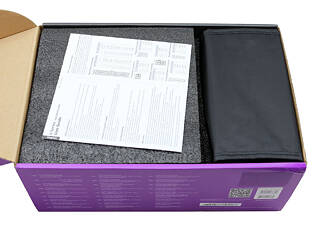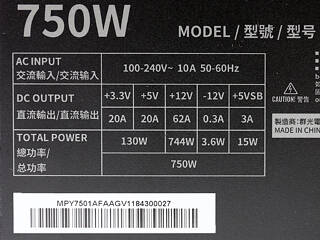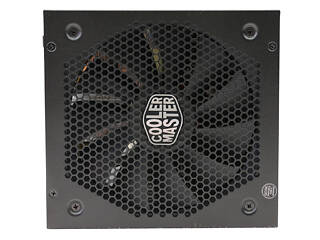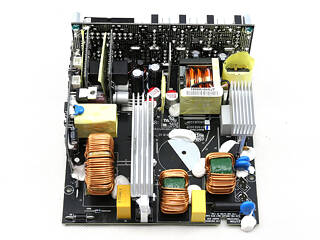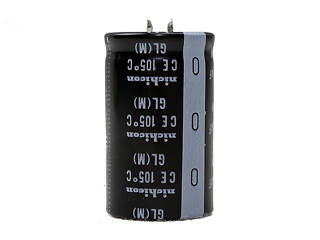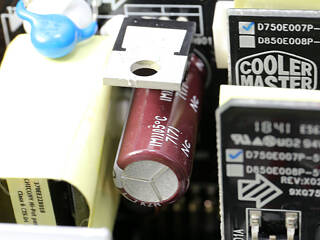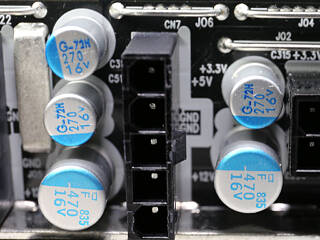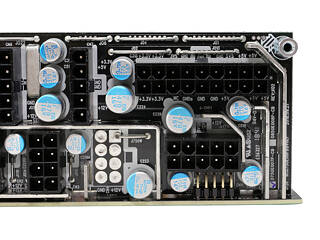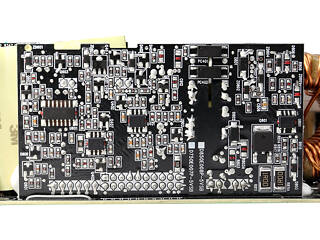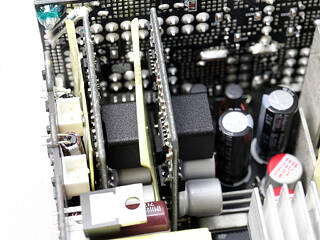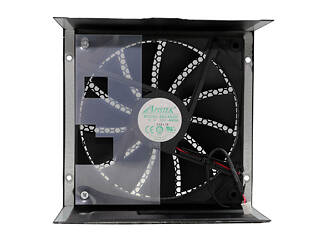 9
9
Cooler Master V Series 750 W Gold Review
Load Regulation, Hold-up Time, Inrush Current, Efficiency & Noise »Introduction

We would like to thank Cooler Master for supplying the review sample.

The new Cooler Master V Gold series consists of four members with capacities ranging from 550 W to 850 W. All of these use a platform by Chicony. The previous V series units were made by Seasonic (V1200, V1000 and V850) and Enhance Electronics (V750, V650 and V550). On CM's site, we still find many of the older V series units on offer, which will probably confuse future buyers. CM most likely has stock of these older models, and until sold out, CM will continue listing them alongside their new models.
The V750 Gold is 80 PLUS Gold certified. In the Cybenetics scale, it has the ETA-A efficiency (88%–91%) and LAMBDA-S+ to LAMBDA-S++ noise certification with 115V input. Its other features include a fully modular cable design, 135 mm fan with a fluid dynamic bearing and semi-fanless mode that can be deactivated should the user want the fan to spin at all times. Finally, like competing offerings from Corsair, Seasonic, and EVGA, the provided warranty is ten years long.
Specifications
| Cooler Master V750 Gold (MPY-7501-AFAAGV) Features & Specs | |
|---|---|
| Max. DC Output | 750 W |
| PFC | Active PFC |
| Efficiency | ETA-A & 80 PLUS Gold |
| Noise | LAMBDA-S++ (33.76 dB[A]) |
| Modular | Yes (fully) |
| Intel C6/C7 Power State Support | Yes |
| Operating temperature | 0 °C - 50 °C |
| Protections | Over Voltage Protection Under Voltage Protection Over Power Protection Over Temperature Protection Over Current Protection Short Circuit Protection |
| Cooling | 135 mm Fluid Dynamic Bearing Fan (APISTEK SAC4H2H) |
| Semi-passive operation | Yes (selectable) |
| Dimensions | 152 mm (W) x 87 mm (H) x 162 mm (D) |
| Weight | 1.635 kg (3.60 lb) |
| Compliance | ATX12V v2.31, EPS 2.92 |
| Warranty | 10 years |
| Price at time of review (exc. VAT) | $119.99 |
| Cooler Master V750 Gold Power Specs | |||||||
|---|---|---|---|---|---|---|---|
| Rail | 3.3V | 5V | 12V | 5VSB | -12V | ||
| Max. Power | 20A | 20A | 62 | 3A | 0.3A | ||
| 130W | 744W | 15W | 3.6W | ||||
| Total Max. Power | 750W | ||||||
Cables and Connectors
| Modular Cables | ||||
|---|---|---|---|---|
| Description | Cable Count | Connector Count (Total) | Gauge | In Cable Capacitors |
| ATX connector 20+4 pin (650 mm) | 1 | 1 | 18-22AWG | No |
| 4+4 pin EPS12V (650 mm) | 1 | 1 | 18AWG | No |
| 8 pin EPS12V (650 mm) | 1 | 1 | 18AWG | No |
| 6+2 pin PCIe (560 mm+120 mm) | 2 | 4 | 18AWG | No |
| SATA (500 mm+120 mm+120 mm+120 mm) | 3 | 12 | 18AWG | No |
| 4 pin Molex (500 mm+120 mm+120 mm+120 mm) | 1 | 4 | 18AWG | No |
| FDD Adapter (125 mm) | 1 | 1 | 22AWG | No |
| AC Power Cord (1350 mm) - C13 coupler | 1 | 1 | 18AWG | - |
There are two EPS and four PCIe connectors, as well as a dozen SATA connectors. All cables are long enough, but the distance between peripheral connectors should at least be 150 mm. Finally, Cooler Master speaks of 16AWG gauges on the PCIe connectors, but I only found 18AWG wires in my sample. I asked them about this and they replied that the mass production samples will have 16AWG gauges as advertised.
Component Analysis
| Cooler Master V750 Parts Description | |
|---|---|
| General Data | |
| Manufacturer (OEM) | Chicony Electronics |
| PCB Type | Single Sided |
| Primary Side | |
| Transient Filter | 4x Y caps, 2x X caps, 2x CM chokes |
| Bridge Rectifier(s) | 2x Lite-On GBU15JL (600 V, 15 A @ 115 °C) |
| Inrush Current Protection | - |
| APFC MOSFETs | 2x Infineon IPP60R120P7 (650 V, 16 A @ 100 °C, 0.12 Ohm) |
| APFC Boost Diode | 1x CREE C3D08060A (600 V, 8 A @ 152 °C) |
| Hold-up Cap(s) | 1x Nichicon (450 V, 560 uF, 2,000h @ 105 °C, GL series) |
| Main Switchers | 2x Toshiba TK16A60W (600 V, 15.8 A @ 150 °C, 0.19 Ohm) |
| APFC Controller | Infineon ICE3PCS03G |
| Resonant Controllers | MPS HR1000A & 2x MPS MP6903 (Installed on the secondary side) |
| Topology | Primary side: Half Bridge & LLC resonant converter Secondary side: Synchronous Rectification & DC-DC converters |
| Secondary Side | |
| +12V | 6x Nexperia PSMN2R6-40YS (40 V, 100 A @ 100 °C, 5.3 mOhm @ 175 °C) |
| 5V & 3.3V | DC-DC Converters: 4x Advanced Power AP0403GH(30 V, 50 A @ 100 °C, 4.5 mOhm) & 2x Advanced Power AP3N4R0H(30 V, 56 A @ 100 °C, 4 mOhm) PWM Controllers: 2x APW7160A |
| Filtering Capacitors | Electrolytics: 4x Rubycon (6 - 10,000 h @ 105 °C, ZLH series), Nippon Chemi-con (5 - 6,000 h @ 105 °C, KZH series), Nippon Chemi-con (4 - 10,000 h @ 105 °C, KY series), Nichicon (5 - 6,000 h @ 105 °C, HV series) Polymers: FPCAP, Nichicon (LG), Nippon Chemi-con |
| Supervisor IC | CP006WD |
| Fan Model | Apistek SAC4H2H (135 mm, 0.5 A, Fluid Dynamic Bearing Fan) |
| 5VSB Circuit | |
| Rectifiers | On Semiconductor MBR20100CT SBR (100 V, 10 A @ 133 °C) & STMicroelectronics STD4N80K5 FET (800 V, 1.7 A @ 100 °C) |
| Standby PWM Controller | 400BBBBB2 PAJH |
The primary side utilizes a half-bridge topology with an LLC resonant converter, which boosts efficiency by lowering the switching losses of the FETs. The heat sinks are small, and the PSU's design is clean, with enough clearance between components to allow for unobstructed airflow, which means the fan doesn't have to spin at high speeds to cope with the thermal load.
Photos of the transient filter, the bridge rectifiers, and the APFC converter. Unfortunately, there is no inrush current protection, which is usually implemented through an NTC thermistor and an electromagnetic relay. To make matters even worse, there is no MOV for protection against voltage spikes from the mains network.
The main switching FETs.
Soldering quality is satisfactory, and there are no long component leads, which I hate to see since they are the first sign of mediocre quality control.
There are many interesting parts on this side of the mainboard, including the +12V FETs and a number of controllers.
The filtering caps on the secondary side are of high quality since they belong to good lines from Rubycon, Chemi-Con, and Nichicon.
To further restrict ripple on all rails, many polymer caps are also installed on the modular board.
This vertical board hosts the 5VSB circuit and protections IC. Both are electrically isolated by two optocouplers.
The two DC-DC converters that generates the minor rails (5V and 3.3V).
The cooling fan is by Apistek, and its model number is SAC4H2H. It measures 135 mm across and uses a fluid dynamic bearing.
May 8th, 2024 18:03 EDT
change timezone
Latest GPU Drivers
New Forum Posts
- Your way of cooling your PC? (35)
- What's a good option for a digital touchless thermometer? (3)
- TPU's Nostalgic Hardware Club (18503)
- Ubuntu 24.04 LTS released (3)
- POLL: Can you see the difference past 60fps (gaming/other) (58)
- not impressed - nvme vs ssd (72)
- im new to throttelstop and i think i messed it up by copying others any hints would be very much aprreciated (14)
- Current Sales, Bundles, Giveaways (10229)
- Does anyone here overclock their video cards? Is it really worth it? (71)
- Arkane Austin and Redfall: what happened? (50)
Popular Reviews
- CHERRY XTRFY M64 Pro Review
- Corsair iCUE Link RX120 RGB 120 mm Fan Review
- Finalmouse UltralightX Review
- Bykski CPU-XPR-C-I CPU Water Block Review - Amazing Value!
- Upcoming Hardware Launches 2023 (Updated Feb 2024)
- Cougar Hotrod Royal Gaming Chair Review
- Meze Audio LIRIC 2nd Generation Closed-Back Headphones Review
- AMD Ryzen 7 7800X3D Review - The Best Gaming CPU
- ASRock NUC BOX-155H (Intel Core Ultra 7 155H) Review
- ASUS Radeon RX 7900 GRE TUF OC Review
Controversial News Posts
- Intel Statement on Stability Issues: "Motherboard Makers to Blame" (261)
- AMD to Redesign Ray Tracing Hardware on RDNA 4 (206)
- Windows 11 Now Officially Adware as Microsoft Embeds Ads in the Start Menu (167)
- NVIDIA to Only Launch the Flagship GeForce RTX 5090 in 2024, Rest of the Series in 2025 (142)
- Sony PlayStation 5 Pro Specifications Confirmed, Console Arrives Before Holidays (119)
- AMD's RDNA 4 GPUs Could Stick with 18 Gbps GDDR6 Memory (114)
- NVIDIA Points Intel Raptor Lake CPU Users to Get Help from Intel Amid System Instability Issues (106)
- AMD Ryzen 9 7900X3D Now at a Mouth-watering $329 (104)



